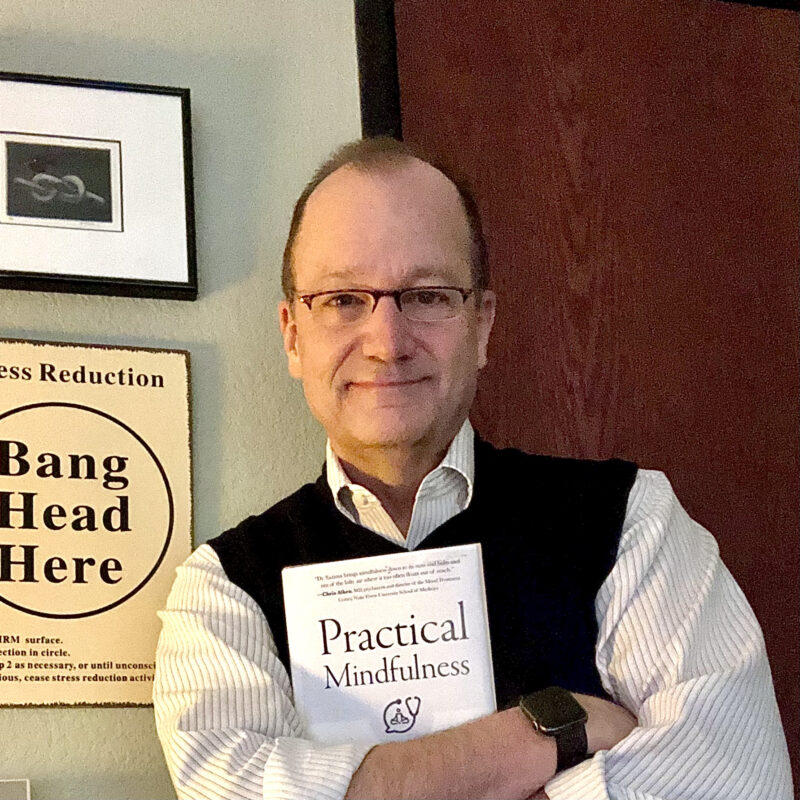Last week’s PM blog, using the awful events in DC as a tableau for mindfully managing a moment of intense experience, was a bit tense; cathartic for some. It was for me. Today, it seems best to throttle back, and provide some lighter banter about Tuesday’s release of Practical Mindfulness. Please forgive the self-centered excitement, my only excuse being the book is an other-centered piece of writing. I’ll run with that.
PM will be available in paperback, e-book and audible formats. A comprehensive website with information on the book, blog, podcast episodes and more, is up for your perusal:
http://www.practicalmindfulnessbook.com
PM comes in at 300 pages even, around 80,000 words, with three parts – each part including some conceptual information on consciousness, mindfulness and meditation, then pivoting to specific, guided exercises in meditation. The intention, as reflected in the title: providing an accessible, engaging way to learn about and entrain mindfulness, our capacity for awareness of experience.
Part I introduces some novel ideas about our experience and how it is constructed, and a basic “landscape” model for observing the moment to moment; then a dive into the basics of breath meditation. It includes basic sitting instructions (the pith: attend, lose it, regain it), and detailed tactics and troubleshooting.
Part II adds another wrinkle, an alternative model for understanding consciousness that weaves evolutionary biology and neurology into the mix – an “operating system” (OS) model. Then, we move over to the training side of things with an expansion of those basic breath training practices into other body and sense experiences, then to emotional phenomena, and thought phenomena as “targets” for our observation. We open out to the whole layered fullness of our experience of self.
Part III concludes PM with an important but speculative section that attends to experiences that can and do occur to us, on the cushion and off – awareness of states of “unity” or “beyond self.” It was tricky to write, as such experiences are actually common and deeply documented in human history, but can be controversial in terms of cause. In threading the needle between the spiritual (it’s a divine thing) and rationalist (it’s a funky effect of neurology), I approach it from an experiential view: when it happens, can we identify it? And what does it present to us as? What stuff gets in the way? The final swivel back to practice approaches the topic by creating optimal circumstances in which to be receptive to an experience of our immersion in a broader “field”.
For service/care professionals in medicine, nursing and education, I’ve added an Appendix on how to teach the very basic aspects of breath meditation to patients and students. While this may work to put the book “out of business,” it’s part of the mission to get more folks training up this privilege – the capacity of mindfulness.
A few historical notes: while I’d been teaching and preaching (irony!) a “secular” approach to mindfulness for 20 years, including seminars and a curriculum for elementary school students, the impetus for getting it all down on paper was more about threat and some desperation. I was diagnosed in 2010 with a rare form of chondrosarcoma, a kind of bone cancer, that was threatening to strangle my spinal cord in my neck and generating increasing misery in my dominant left arm and hand. Three recurrences and four surgeries later, I was in some dire straits in 2014 – surgeries ineffective in stopping the increasing aggressive bugger. With some alarming mortality risk numbers overheating my mind,
I opted for a risky blast of intense radiation to stop the tumor from growing in early 2015 – and an intense drive to write down all I knew about meditation. While recovering (albeit with some residual disability – radiating cancerous tissue four millimeters from my spinal cord inevitably with a local sautéing of the cord nearby), I organized all I knew about mindfulness and meditation, then set about to write before my clinical hours and on weekends. About four years later, I was still kicking, with a completed… doorstop. 175,000 words. Editor?
Editing proceeded, as well as a newbie’s naive efforts to get an agent and/or a publisher interested. One comic response: “we like books to fly off the shelves. Yours appears to be a flightless bird.” (Awful, but, well, pretty f****ing funny.)
Editorial cleaver in hand, I found that the manuscript could be sensibly cleaved into two. PM is a basic, introductory approach to the topic. A follow-up work that focuses on using PM concepts and practices in a “life in motion” – addressing change, grief and growth – is in progress. Fingers are crossed on PM’s success to move ahead with that bit of partially-finished piece of writing.
For the here and now, my deep gratitude to all who have helped birth PM.
Take care, and keep staying safe.
GCS
